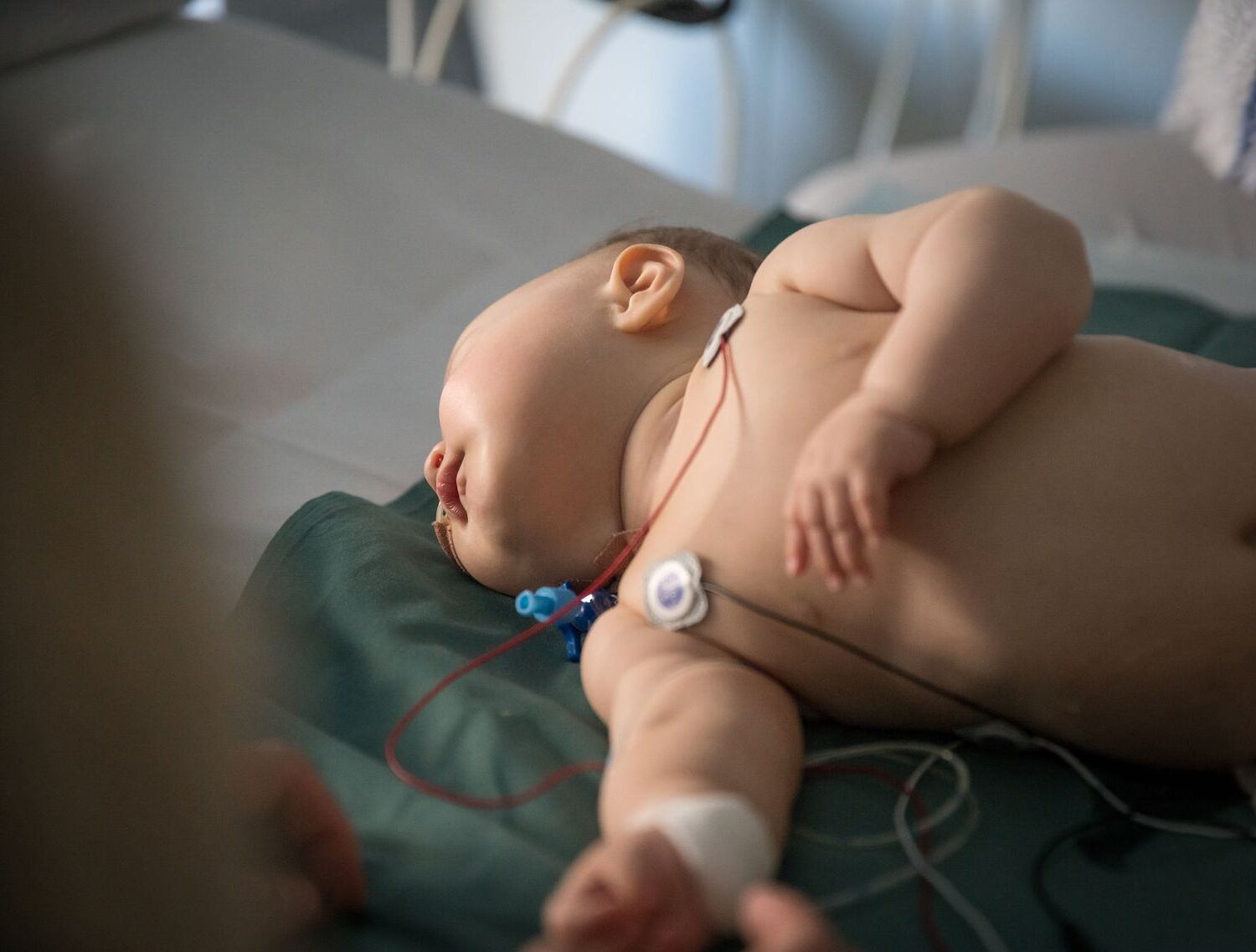
What is Hypoplastic Right Heart Syndrome (HRHS)? Hypoplastic Right Heart Syndrome (HRHS) is a rare congenital heart defect where the right side of the heart, including the tricuspid valve, right ventricle, and pulmonary valve, is underdeveloped. This condition leads to inadequate blood flow to the lungs, causing insufficient oxygenation of the blood. HRHS affects approximately 1 in 60,000 births in the United States. Symptoms often include cyanosis, rapid or difficult breathing, poor feeding, and cold extremities. While the exact cause remains unknown, genetic factors and family history may play a role. Early diagnosis and a series of surgical interventions are crucial for improving the heart's function and increasing blood flow to the lungs.
Understanding Hypoplastic Right Heart Syndrome
Hypoplastic Right Heart Syndrome (HRHS) is a rare and complex congenital heart defect. It affects the right side of the heart, leading to significant challenges in blood flow and oxygenation. Let's dive into some key facts about this condition.
-
Definition and Prevalence: HRHS is a congenital heart defect where the right side of the heart, including the tricuspid valve, right ventricle, and pulmonary valve, is underdeveloped or not formed properly.
-
Incidence: In the United States, HRHS occurs in approximately 1 in 60,000 births. This makes it less common than hypoplastic left heart syndrome (HLHS), which occurs in 1 in 4,300 births.
Recognizing the Symptoms
Early detection of HRHS can be life-saving. Understanding the symptoms can help in seeking timely medical intervention.
- Symptoms: Common symptoms include cyanosis (a grayish-blue coloration of the skin, lips, fingernails, and other parts of the body), rapid or difficult breathing, poor feeding due to lack of energy, cold hands or feet, and being inactive and drowsy.
Causes and Pathogenesis
The exact causes of HRHS remain a mystery, but certain factors are believed to contribute to its development.
-
Causes: The exact cause of HRHS is unknown, but a family history of similar heart defects can increase the risk. Certain genes may also play a role. However, it can also manifest in a child without a family history of congenital heart abnormalities.
-
Pathogenesis: HRHS involves the underdevelopment of the right side of the heart, including the tricuspid valve, right ventricle, and pulmonary valve. This leads to inadequate blood flow to the lungs, resulting in insufficient oxygenation of the blood.
Anatomy of the Heart
Understanding the anatomy of a healthy heart versus one affected by HRHS is crucial for grasping the severity of this condition.
- Anatomy: A healthy heart has four chambers: two atria and two ventricles, separated by valves that control blood flow between the chambers. In HRHS, the right ventricle is smaller and weaker, preventing normal blood flow to the lungs.
Diagnostic Methods
Early and accurate diagnosis is essential for managing HRHS effectively.
- Diagnostic Methods: HRHS can be diagnosed prenatally using a fetal echocardiogram, a non-invasive ultrasound test that shows the structure and function of the fetal heart.
Treatment Overview
While there is no cure for HRHS, various surgical interventions can significantly improve the quality of life for affected individuals.
- Treatment Overview: A series of surgical interventions can improve the heart's function and increase blood flow to the lungs. These surgeries are typically necessary for survival beyond infancy.
Surgical Interventions
Surgical procedures are often required to manage HRHS. These surgeries are performed in stages to gradually improve heart function.
-
First Stage Surgery (BT Shunt): The first stage of surgery involves inserting a Blalock-Taussig shunt, a small tube that delivers blood flow to the lungs. This procedure is usually performed within the first week of life.
-
Second Stage Surgery (Glenn Procedure): At around 4 to 6 months of age, the Glenn procedure is performed. This connects the superior vena cava directly to the pulmonary artery, allowing oxygen-poor blood from the upper body to go straight to the lungs for oxygenation.
-
Third Stage Surgery (Fontan Procedure): Between ages 2 and 4, the Fontan procedure is performed. This connects the inferior vena cava to the pulmonary artery, allowing oxygen-poor blood from the lower body to get oxygen directly from the lungs.
Additional Medical Interventions
Apart from surgeries, other medical interventions play a crucial role in managing HRHS.
-
Prostaglandin E1 (PGE1) Infusion: After birth, babies with HRHS require continuous infusion of PGE1 to keep the patent ductus arteriosus (PDA) open. The PDA allows blood to bypass the underdeveloped right side of the heart and flow to the lungs.
-
Cardiac Catheterization: In some cases, cardiac catheterization may be required to perform a balloon atrial septostomy or to help open the pulmonary valve. This procedure involves placing a thin flexible tube through the umbilical vein and using a balloon to create a larger hole between the top chambers of the heart.
Specific Conditions Related to HRHS
HRHS can be associated with other specific heart conditions, each requiring unique management strategies.
-
Tricuspid Atresia: Tricuspid atresia is a condition where the tricuspid valve does not form, preventing blood from entering the right ventricle and pulmonary artery. This leads to a smaller and weaker right ventricle.
-
Pulmonary Atresia: Pulmonary atresia is a condition where the pulmonary valve does not form, preventing blood from flowing to the lungs. This requires creating a new route for blood to get to the lungs.
-
Tricuspid Stenosis: Tricuspid stenosis occurs when the tricuspid valve is too small, restricting blood flow between the right atrium and right ventricle.
-
Pulmonary Stenosis: Pulmonary stenosis occurs when the pulmonary valve is too small, restricting blood flow between the right ventricle and pulmonary artery.
Impact on Oxygenation
The primary challenge in HRHS is ensuring adequate oxygenation of the blood.
- Impact on Oxygenation: The underdevelopment of the right side of the heart leads to inadequate blood flow to the lungs, resulting in insufficient oxygenation of the blood. This can cause various symptoms and complications.
Collaborative Care
Managing HRHS requires a team of specialists working together to provide comprehensive care.
- Collaborative Care: The treatment of HRHS requires a multidisciplinary team including pediatric cardiologists, neonatologists, and cardiothoracic surgeons. Close collaboration and communication among these specialists are crucial for effective care coordination.
Prenatal and Postnatal Care
Early diagnosis and immediate care after birth are vital for babies with HRHS.
-
Prenatal Diagnosis: Prenatal diagnosis of HRHS is essential for planning immediate and emergency treatment after birth. Pregnant women with suspected HRHS should be referred to a level 3 hospital with pediatric cardiology and cardiothoracic surgical teams.
-
Delivery and Postnatal Care: Babies with HRHS are best delivered at a medical center with access to a team of pediatric cardiologists and neonatologists, along with an established Neonatal Intensive Care Unit (NICU). In severe cases, a Cesarean Section may be necessary.
Prognosis and Future Care
The long-term outlook for individuals with HRHS varies, but advancements in treatment offer hope.
- Prognosis and Future Care: The prognosis for babies with HRHS varies depending on the severity of the defect and the effectiveness of surgical interventions. Some individuals may require additional interventions or even a heart transplant later in life.
Genetic Factors and Associated Conditions
Genetics can play a role in HRHS, and it may be linked with other congenital heart defects.
-
Genetic Factors: While the exact cause of HRHS is unknown, genetic factors may play a role. A family history of congenital heart defects can increase the risk, and certain genes may be involved.
-
Associated Conditions: HRHS can be associated with other congenital heart defects, such as aortic stenosis. The presence of these additional defects can complicate treatment and affect the overall prognosis.
Advancements in Treatment
Medical advancements have significantly improved the management of HRHS, offering better outcomes for affected individuals.
- Advancements in Treatment: Over the past few decades, treatments for HRHS have significantly improved. The development of new surgical techniques and technologies has enhanced the ability to manage this complex condition, improving survival rates and quality of life for affected individuals.
Understanding Hypoplastic Right Heart Syndrome
Hypoplastic Right Heart Syndrome (HRHS) is a rare but serious congenital heart defect. It involves the underdevelopment of the right side of the heart, affecting the tricuspid valve, right ventricle, and pulmonary valve. This condition leads to inadequate blood flow to the lungs, causing symptoms like cyanosis, rapid breathing, and poor feeding. Early diagnosis through fetal echocardiograms and immediate postnatal care are crucial. Treatment typically involves a series of surgeries, including the Blalock-Taussig shunt, Glenn procedure, and Fontan procedure, to improve blood flow and oxygenation. Continuous care from a multidisciplinary team is essential for managing HRHS. While there's no cure, advancements in medical technology have significantly improved outcomes. Understanding HRHS helps in providing better care and support for affected individuals and their families.
Was this page helpful?
Our commitment to delivering trustworthy and engaging content is at the heart of what we do. Each fact on our site is contributed by real users like you, bringing a wealth of diverse insights and information. To ensure the highest standards of accuracy and reliability, our dedicated editors meticulously review each submission. This process guarantees that the facts we share are not only fascinating but also credible. Trust in our commitment to quality and authenticity as you explore and learn with us.


